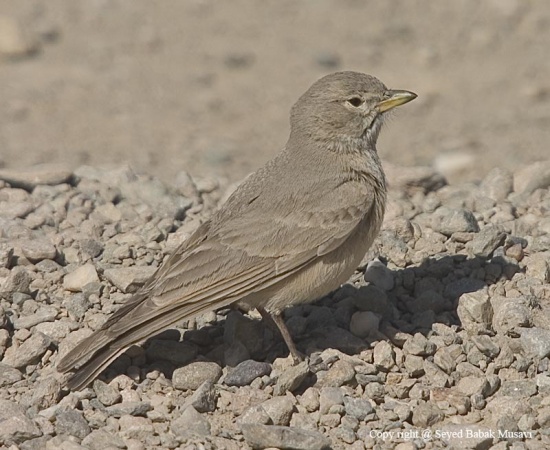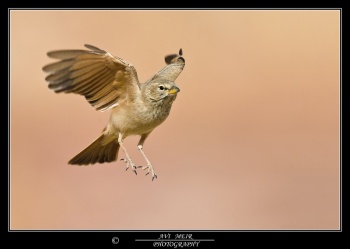- Ammomanes deserti
Identification
15–17 cm (6-6¾ in)
- Sandy upperparts
- Pale pink grey underparts
- Rufous tail with dark terminal band
- Thick yellow bill
- Sexes alike
There is some colour variation according to subspecies.
Distribution
Africa, Middle East and Asia:
Northern Africa: Morocco, Algeria, Tunisia, Libya, Egypt
Western Africa: Mauritania, Mali, Burkina Faso, Nigeria, Niger, Chad
Eastern Africa: Sudan, Eritrea, Ethiopia, Djibouti, Somalia
Middle East: Turkey, Syria, Lebanon, Israel, Jordan, Arabian Peninsula, Saudi Arabia, Yemen, Oman, United Arab Emirates, Qatar, Bahrain, Kuwait, Iraq, Iran
Asia: Uzbekistan, Turkmenistan, Tajikistan, Afghanistan, Pakistan, India, Western Himalayas
Taxonomy
Subspecies
There are 22 subspecies[1]:
- A. d. payni: Morocco south of the High Atlas and adjacent south-western Algeria
- A. d. algeriensis: Northern Algeria to Tunisia and north-western Libya
- A. d. mya: Central Algerian Sahara (between 27øN and 30øN)
- A. d. geyri: Mauritania to southern Algeria and north-western Niger (Air Massif)
- A. d. whitakeri: South-eastern Algeria to south-western Libya and north-western Chad (Tibesti Mountains)
- A. d. kollmanspergeri: North-eastern Chad (Ennedi Mountains) and western Sudan (Darfur)
- A. d. isabellina: Northern Egypt (west of the Nile Valley) east to Israel, Jordan, Syria, southern Turkey (Birecik), northwestern Saudi Arabia, and Iraq (west of the Tigris River)
- A. d. deserti: Eastern Egypt (east of Nile to Red Sea) south to Sudan
- A. d. erythrochroa: Western Chad (Ndjamena) to northern Sudan (Dongola to Kordofan)
- A. d. samharensis: Red Sea coast of eastern Sudan, Eritrea and Arabian Peninsula (south to northern Yemen)
- A. d. assabensis: Southern Eritrea, Ethiopia and north-western Somalia
- A. d. akeleyi: Highlands of northern Somalia
- A. d. annae: Black lava deserts of Jordan (Azraq area) and extreme southern Syria
- A. d. azizi: North-eastern Saudi Arabia (Al Hufuf area)
- A. d. saturata: Black lava deserts of southern Arabia (northern Hijaz to Aden)
- A. d. insularis: Bahrain (Persian Gulf)
- A. d. taimuri: Oman (Muscat area)
- A. d. cheesmani: Iraq (east of Tigris River) to western Iran (west of Zagros Mountains to Persian Gulf
- A. d. parvirostris: Western Turkmenistan (Kara-Bogaz-Gol to Kopet Dagh and Atrak Basin)
- A. d. orientalis: North-eastern Iran, Turkestan and northern Afghanistan
- A. d. iranica: central, southern, and eastern Iran (including the southern Zagros Mountains) east to southwestern Afghanistan and western Pakistan (Baluchistan)
- A. d. phoenicuroides: South-eastern Afghanistan, eastern Pakistan and north-western India (extreme western Rajasthan)
Habitat
Semi desert and deserts.
Behaviour
Breeding
It is a ground nester, building the nest in rocks or stones. The clutch consists of 3-4 eggs.
Diet
The diet consists of small seeds and insects.
Vocalisation
Song' choo-wee-chacha wooee.
References
- Clements, J. F., T. S. Schulenberg, M. J. Iliff, S. M. Billerman, T. A. Fredericks, J. A. Gerbracht, D. Lepage, B. L. Sullivan, and C. L. Wood. 2021. The eBird/Clements checklist of Birds of the World: v2021. Downloaded from https://www.birds.cornell.edu/clementschecklist/download/
- Avibase
- Wikipedia
Recommended Citation
- BirdForum Opus contributors. (2025) Desert Lark. In: BirdForum, the forum for wild birds and birding. Retrieved 27 April 2025 from https://www.birdforum.net/opus/Desert_Lark
External Links





